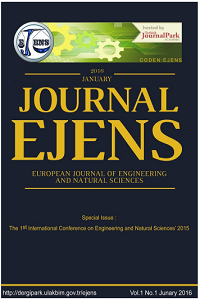Influence of Opening Ratio and Position in Infill Wall on Constitutive Law of Equivalent Compression Strut
Influence of Opening Ratio and Position in Infill Wall on Constitutive Law of Equivalent Compression Strut
Infill walls with openings, Opening ratio and positions force-displacement relationship, equivalent compression strut,
___
- K. M. Mosalam, R. N. White, and P. Gergely, “Static response of infilled frames usıng quasi-static experimentation,” Journal of Structural Engineering, vol. 123(11), pp. 1462–1469, 1997.
- H. B. Kaushik, D. C. Rai, and S. K. Jain, “Stress-strain characteristics of clay brick masonry under uniaxial compression,” Journal of Materials in Civil Engineering, vol. 19(9), pp. 728–739, 2007.
- D. J. Kakaletsis, and C. G. Karayannis, “Experimental investigation of infilled reinforced concrete frames with opening,” ACI Structural Journal, vol. 106(2), pp. 132–141, 2009.
- P. G. Asteris, D. J. Kakaletsis, C. Z. Chrysostomou, and E. E. Smyrou, “Failure modes of in-filled frames,” Electronic Journal of Structural Engineering, vol. 11(1), pp. 11–20, 2011.
- S. M. M. Emami, and M. Mohammadi, “Influence of vertical load on in-plane behavior of masonry infilled steel frames,” Earthquakes and Structures, vol. 11(4), pp. 609-627, 2016.
- M. Bolhassani, A. A. Hamid, C. Johnson, and A. E. Schultz, “Shear strength expression for partially grouted masonry walls,” Engineering Structures, vol. 127, pp. 475-494, 2016.
- M. Dolsek, and P. Fajfar, “Mathematical modelling of an infilled RC frame structure based on the results of pseudo-dynamic tests,” Earthquake Engineering and Structural Dynamics, vol. 31(6), pp. 1215–1230, 2002.
- G. Mondal, and S. K. Jain, “Lateral stiffness of masonry infilled reinforced concrete (RC) frames with central opening,” Earthquake Spectra, vol. 24(3), pp. 701–723, 2008.
- E. Smyrou, C. Blandon, S. Antoniou, R. Pinho, and F. Crisafulli, “Implementation and verification of a masonry panel model for nonlinear dynamic analysis of infilled RC frames,” Bulletin of Earthquake Engineering, vol. 9(5), pp. 1519–1534, 2011.
- A. Fiore, F. Porco, D. Raffaele, and G. Uva,. “About the influence of the infill panels over the collapse mechanisms actived under pushover analyses: Two case studies,” Soil Dynamics and Earthquake Engineering, vol. 39, pp. 11–22, 2012.
- E. Martinelli, C. Lima, and G. D. Stefano, “A simplified procedure for nonlinear static analysis of masonry infilled RC frames,” Engineering Structures, vol. 101, pp. 591–608, 2015.
- P. G. Asteris, C. C. Repapis, A. K. Tsaris, F. D. Trapani, and L. Cavaleri, “Parameters affecting the fundamental period of infilled RC frame structures,” Earthquakes and Structures, vol. 9(5), pp. 999–1028, 2015.
- O. Ozturkoglu, T. Ucar, and Y. Yesilce, “Effect of masonry infill walls with openings on nonlinear response of reinforced concrete frames,” Earthquakes and Structures, vol. 12(3), pp. 333–347, 2017.
- G. Uva, D. Raffaele, F. Porco, and A. Fiore, “On the role of equivalent strut models in the seismic assessment of infilled RC buildings,” Engineering Structures, vol. 42, pp. 83–94, 2012.
- A. Madan, A. M. Reinborn, J. B. Mander, and R. E. Valles, “Modeling of masonry infill panels for structural analysis,” Journal of Structural Engineering, vol. 123(10), pp. 1295–1307, 1997.
- P. Ricci, G. M. Verderame, and G. Manfredi, “Analytical investigation of elastic period of infilled RC MRF buildings,” Engineering Structures, vol. 33(2), pp. 308–319, 2011.
- G. Uva, F. Porco, and A. Fiore, “Appraisal of masonry infill walls effect in the seismic response of RC framed buildings: A case study,” Engineering Structures, vol. 34, pp. 514–526, 2012.
- M. Ercolino, P. Ricci, G. Magliulo, and G.M Verderame, “Influence of infill panels on an irregular RC building designed according to seismic code,” Earthquakes and Structures, vol. 10(2), pp. 261–291, 2016.
- S. H. Bertoldi, L. D. Decanini, and C. Gavarini, “Telai tamponati soggetti ad azioni sismiche, un modello semplificato: confronto sperimentale e numeric,” in Proc. Atti del 6° Convegno Nazionale L’ingegneria Sismica in Italia, Perugia, Italy, 1993.
- T. B. Panagiotakos, and M. N. Fardis, “Proposed nonlinear strut models for infill panels,” University of Patras, Greece, 1st Year Progress Report of HCM-PREC8 Project, 1994.
- K. B. Hanoglu, “Fiber reinforced plastic overlay retrofit of hollow clay tile masonry infilled reinforced concrete frames,” PhD Thesis, Bogazici University, Istanbul, Turkey, 2002.
- M. Dolsek, and P. Fajfar, “The effect of masonry infills on the seismic response of a four-storey reinforced concrete frame-a deterministic assessment,” Engineering Structures, vol. 30(7), pp. 1991–2001, 2008.
- H. Rodrigues, H. Varum, and A. Costa, “Simplified macro-model for infill masonry panels,” Journal of Earthquake Engineering, vol. 14(3), pp. 390-416, 2010.
- M. H. Tsai, and T. C. Huang, “Numerical investigation on the progressive collapse resistance of an RC building with brick infills under column loss,” World Academy of Science, Engineering and Technology, vol. 58, pp. 946–953, 2011.
- SAP2000 Integrated Structural Analysis and Design Software, Ver.16.0.0, Computer and Structures Inc., USA, 2016.
- Prestandard and Commentary for the Seismic Rehabilitation of Buildings (FEMA 356), Federal Emergency Management Agency, Washington, D.C., 2000.
- Başlangıç: 2015
- Yayıncı: CNR Çevre
A Useful Way to Dispose of Phenolic-rich Agro-industrial Wastes: Mushroom Cultivation
MATLAB GUI Model for PV System Feasibility of a House Electricity Consumption in Turkey
Kübra Nur Akpınar, Ayşe Ceyda BİLÜ, Bedri KEKEZOĞLU
Recent advances in membrane fouling control in wastewater treatment processes
Amar CEMANOVİC, Neslihan MANAV, Abdullah KIZILET, Özer ÇINAR
Determination of Appropriate Distribution Functions for the Wind Speed Data Using the R Language
Characteristics of Some Turkish Lignites and Potential of Using in Agricultural Sector
Influence of Pouring Temperature on The Formation of Spheroidal and Lamellar Graphite In Cast Iron
The effect of the consideration of slab dimensions on optimum design of reinforced concrete beams
Sinan Melih Nigdeli, Gebrail Bekdaş
Investigation of Silica Aerogels Effect on Paint Characteristics
